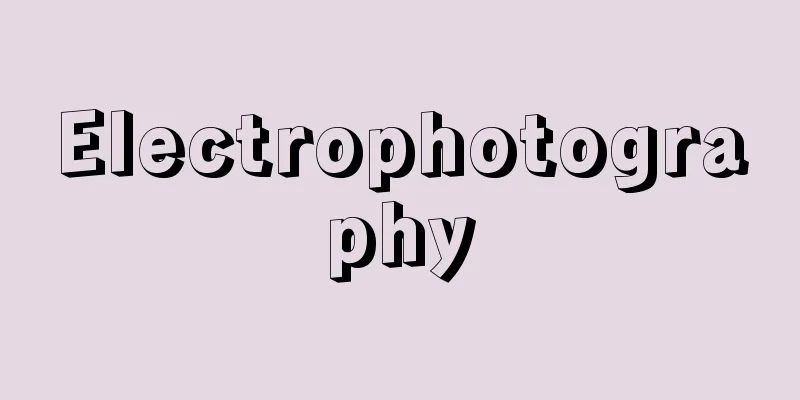Electrophotography

|
Electrophotography is an image formation method that uses photoconductivity and static electricity. It is also called electrophotography, xerography, or the Carlson process after the inventor of electrophotography. It is widely used in copying machines, page printers and plain paper facsimiles as computer output terminals, and electrophotographic printers for on-demand printing that print the required number of copies when needed. [Kitamura Takashi] Electrophotographic ProcessIn 1938, American Chester Floyd Carlson (1906-1968) invented electrophotography, which uses photoconductivity and static electricity. Manual electrophotographic copying machines were put into practical use in 1950, and the first automatic office electrophotographic copying machine was released in 1959. The electrophotographic image forming process consists of the steps of corona charging, image exposure, toner development, transfer, fixing and cleaning. (1) Corona Charging A corona charger applies a uniform charge to the surface of the photoconductor. (2) Image exposure: The document is illuminated with light from a fluorescent lamp or the like, and the reflected light is irradiated onto the photoconductor. When the light reflected from the document is irradiated onto the photoconductor, a charge is generated by the photoconductive phenomenon, which moves inside the photoconductor and dissipates the surface charge. In this way, the white parts of the document, i.e., areas other than the image area, become charge-free, and a charge image is created in which only the image area is charged. (3) Toner development When colored particles called toner approach the charged image on the photoconductor, the toner is attracted by Coulomb force (electrostatic force) and adheres to the surface of the photoconductor. The toner adheres only to the areas on the photoconductor surface where there is a charge, making it visible to the naked eye. (4) Transfer The toner image on the photoconductor is transferred to plain paper. Plain paper is placed on top of the toner image, and corona charging is performed from the back of the paper, transferring the toner to the front of the paper. (5) Fixation The paper that has been separated from the photoconductor surface is heated by the fixing roller. The fixing roller is heated to a high temperature, and the resin contained in the toner melts and fixes it onto the paper. (6) Cleaning: Any toner remaining on the surface of the photoconductor is removed. Each process is arranged around the circumference of the photoconductor drum, and one copy is completed by one rotation of the photoconductor drum, or several rotations in the case of a small-diameter photoconductor drum. Powder toner is generally used, but there are also devices that use liquid toner. [Kitamura Takashi] Electrophotographic printerElectrophotography is used in copiers and electrophotographic printers that make hard copies of documents and images created by a computer. In the printer, the light from a semiconductor laser or light-emitting diode is changed by an electrical signal from the computer, and the light is irradiated onto a photoconductor. After that, toner development and transfer onto paper are performed to obtain a hard copy. [Kitamura Takashi] Color electrophotographyMost copies are monochrome, but full color copies are also being made. In color electronic photography, like color printing, the image is separated into the three primary colors of red, green, and blue, and then image processing and signal conversion are performed to make the red latent image visible using cyan toner, the green latent image visible using magenta toner, and the blue latent image visible using yellow toner. Black toner is then added to the three color toners, and the four color toner images are superimposed to make a full color copy. [Kitamura Takashi] Characteristics of electrophotographyElectrophotography is characterized by high image quality and fast output speed. Image definition is indicated by resolution, which is conventionally expressed as the number of dots formed per inch (dpi = dots per inch). 600 dpi is the standard for current electrophotographic printers, and the size of each dot is so small that it cannot be seen with the naked eye. In addition, the resolution of characters and image edges is increased by smoothing processing, improving image quality. [Kitamura Takashi] "The Society of Electrophotography (ed.), "Fundamentals and Applications of Electrophotography" (1986, Corona Publishing)" ▽ "The Society of Electrophotography (ed.), "Further Fundamentals and Applications of Electrophotography" (1996, Corona Publishing)" ▽ "The Japan Society of Photographic Society and the Japan Society of Imaging Science Joint Publishing Committee (ed.), "Fine Imaging and Hardcopy" (1999, Corona Publishing)" ▽ "Digital Hardcopy Technology and Materials - The Latest Electrophotographic Technology and Its Materials" edited by Takahashi Kyosuke and Kitamura Takashi (1999, CMC)" ▽ "The Latest Technology of Toner and Toner Materials" edited by Mentani Makoto (2000, CMC)" ▽ "Electrophotography - Process and Simulation" edited by the Japan Society of Photographic Society and edited by Hirakura Koji and Kawamoto Hiroyuki (2008, Tokyo Denki University Press)" [Reference] | |Source: Shogakukan Encyclopedia Nipponica About Encyclopedia Nipponica Information | Legend |
|
電子写真は光導電現象と静電気を利用した画像形成法である。エレクトロフォトグラフィー、ゼログラフィーxerographyあるいは電子写真法の発明者の名前をつけてカールソン法ともよぶ。複写機(コピー機)およびコンピュータ出力端末としてのページプリンターや普通紙ファクシミリ、さらに必要なときに必要な部数を印刷するオンデマンド印刷用電子写真印刷機などに広く利用されている。 [北村孝司] 電子写真のプロセス1938年にアメリカのカールソンChester Floyd Carlson(1906―1968)が光導電現象と静電気を用いた電子写真法を発明した。1950年に手動の電子写真複写機が実用化され、1959年に初めて自動の事務用電子写真複写機が発売された。 電子写真の画像形成プロセスは、コロナ帯電、画像露光、トナー現像、転写、定着およびクリーニングの各ステップから構成されている。 (1)コロナ帯電 コロナ帯電器により感光体表面に均一に電荷を与える。 (2)画像露光 原稿を蛍光灯などの光で照明し、その反射光を感光体に照射する。原稿からの反射光が感光体に照射されると光導電現象により電荷が生成し感光体内を移動して表面の帯電電荷が消失する。このようにして、原稿の白い部分つまり画像部以外のところは帯電がなくなり、画像部のみが帯電している電荷像ができる。 (3)トナー現像 トナーとよぶ着色された微粒子が感光体上の電荷像に接近するとクーロン引力(静電引力)によりトナーが引き寄せられ感光体表面に付着する。感光体表面の電荷が存在するところだけにトナーが付着し、目で見ることができるようになる。 (4)転写 感光体上にできたトナー像を普通紙に移動させる。普通紙をトナー像の上に重ね、紙の裏面からコロナ帯電を行うとトナーは紙表面に転写される。 (5)定着 感光体表面から引き離された紙は定着ローラにて加熱される。定着ローラは高温に加熱されており、トナーに含まれる樹脂が溶融して紙上に固定される。 (6)クリーニング 感光体の表面に残ったトナーが取り除かれる。 各工程が感光体ドラムの円周上に配置されており、感光体ドラムが1回転することにより、あるいは直径の小さな感光体ドラムの場合では数回転することにより1枚のコピーができあがる。なお、トナーには一般には粉体トナーが使用されるが、液体トナーを用いる機器もある。 [北村孝司] 電子写真プリンター電子写真は複写機のほかにコンピュータで作成した文書や画像のハードコピーをつくる電子写真プリンターに使用されている。プリンターではコンピュータからの電気信号により半導体レーザーあるいは発光ダイオードの光を変化させ、その光を感光体に照射する。その後、トナー現像および紙への転写が行われハードコピーを得ることができる。 [北村孝司] カラー電子写真コピーは単色が主であるがフルカラー化も行われている。カラー電子写真はカラー印刷と同様に、画像を赤(レッド)、緑(グリーン)、青(ブルー)の三原色に色分解したのち画像処理および信号変換を行い、赤色潜像をシアン、緑色潜像をマゼンタ、青色潜像をイエローのトナーで可視画像化する。さらに3色のトナーにブラックのトナーを加えて4色のトナー像を重ね合わせてフルカラーコピーをつくる。 [北村孝司] 電子写真の特徴電子写真は画像品質が高く、出力スピードが早いという特徴を有する。画像の精細度は解像度で示され、慣用的であるが1インチ当りに形成するドット数(単位はdpi=dot per inch)で表す。現在の電子写真プリンターでは、600dpiが標準的であり、ドット1個の大きさは目で確認できないほど小さい。また、文字や画像のエッジはスムージング処理により解像度が高められ、画像品質の向上が図られている。 [北村孝司] 『電子写真学会編『電子写真技術の基礎と応用』(1986・コロナ社)』▽『電子写真学会編『続電子写真技術の基礎と応用』(1996・コロナ社)』▽『日本写真学会・日本画像学会合同出版委員会編『ファインイメージングとハードコピー』(1999・コロナ社)』▽『高橋恭介・北村孝司監修『ディジタルハードコピー技術と材料――最新の電子写真技術とその材料』(1999・シーエムシー)』▽『面谷信監修『トナーおよびトナー材料の最新技術』(2000・シーエムシー)』▽『日本画像学会編、平倉浩治・川本広行監修『電子写真――プロセスとシミュレーション』(2008・東京電機大学出版局)』 [参照項目] | |出典 小学館 日本大百科全書(ニッポニカ)日本大百科全書(ニッポニカ)について 情報 | 凡例 |
>>: Electromagnet - Electric magnet
Recommend
Tsugaru Current - Tsugaru Current
A warm current that flows out of the Tsugaru Strai...
Paris, G. (English spelling) ParisG
…French father and son. The father, Paulin Paris ...
Yoshishige Nitta
A military commander from the end of the Heian pe...
Mason-Dixon Line
The border between the states of Pennsylvania, Mar...
Azumaya Urataro - Azumaya Urataro
...Naniwabushi, which became popular throughout t...
Real estate theft crime
It is a crime of usurping the real property of ot...
Domon
A decorative technique in which pieces of embossed...
Archegonia - Zoranki
It is an organ that forms female gametes (also ca...
Satsuma Province - Satsuma no Kuni
A province in the Kyushu region of the Saikaido. ...
Voyage - Koukai
〘 noun 〙 To cross the sea by boat. To navigate the...
Aku - Evil
…One of the three ancient Egyptian spiritual conc...
Wood-drifting worker - Kinagashi-ko
...(1) Methods for preventing overflowing: stacki...
Taxpayer - taxpayer
A person who is obligated to pay taxes (tax liabil...
Dionysius
…A Christian saint from the mid-3rd century and t...
Textile industry
A general term for the silk-reeling, spinning, che...









